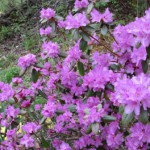 All azaleas are rhododendrons, but not all rhodies are azaleas. And not all small leaved rhodies are azaleas either. Rhododendron is a huge genus (group of species) that has over a thousand species in the wild, and there are also thousands of varieties developed by horticulturalists. Many of these species are tropical and not suited for our gardens here in Delaware County. One subgroup of rhodie species, the Vireya group, is found throughout the Malay Archipelagos and even reaches into northern Australia.
All azaleas are rhododendrons, but not all rhodies are azaleas. And not all small leaved rhodies are azaleas either. Rhododendron is a huge genus (group of species) that has over a thousand species in the wild, and there are also thousands of varieties developed by horticulturalists. Many of these species are tropical and not suited for our gardens here in Delaware County. One subgroup of rhodie species, the Vireya group, is found throughout the Malay Archipelagos and even reaches into northern Australia.
Azaleas are included within the genus Rhododendron. There are two rhodie species subgroups commonly known as Azaleas. The Tsusuji Azalea subgroup is found in Asia and has cultural significance in Japan. The Korean Poukanense variety is a representative of this group that has become commercially available in our area recently, but is not yet common in our gardens. The other azalea subgroup consists of species native to eastern North America and these are the azaleas we find in our gardens here.
Here in Delaware County, there are three major types of rhododendrons commonly found in our gardens:
 1) native azaleas – mentioned above, these lose their smaller leaves during the winter and have single flowers at the end of branches. They have leaves with scattered brown bristles. Native azaleas flowers come in yellow and orange as well as white, pink and purple. The most well known azalea in our gardens is the Pinkster. This photo shows a typical azalea flowering habit.
1) native azaleas – mentioned above, these lose their smaller leaves during the winter and have single flowers at the end of branches. They have leaves with scattered brown bristles. Native azaleas flowers come in yellow and orange as well as white, pink and purple. The most well known azalea in our gardens is the Pinkster. This photo shows a typical azalea flowering habit.
 2) large-leafed rhododendrons –these keep their leaves through the winter and have large trusses of flowers conspicuously clustered at the end of branches. Some have brown fuzz on the leaf undersides. These rhodies often have relatively huge leaves and can be very large overall.
2) large-leafed rhododendrons –these keep their leaves through the winter and have large trusses of flowers conspicuously clustered at the end of branches. Some have brown fuzz on the leaf undersides. These rhodies often have relatively huge leaves and can be very large overall.
3) small-leafed rhododendrons – these also keep their leaves through the winter and have small clusters of flowers scattered all over the shrub so that it looks covered with blooms. All have brown fuzz on their leaf undersides. Rhododendron ‘PJM’ is a variety in this group very common in our area (top photo).
Azaleas and many rhodies have smooth undersides to their leaves. If you have a rhodie with small leaves AND brown fuzz on the leaf undersides, it is not an azalea, it is a small leafed rhododendron. If you have a rhodie with orange or yellow flowers, it is an azalea.
 This picture shows the undersides of leaves from each of the three groups. On the left is the small-leafed rhododendron with its coating of brown fuzz; center is the leaf of an azalea with its scattered brown bristles, and right is the smooth underside of the leaf of a large-leaved rhododendron.
This picture shows the undersides of leaves from each of the three groups. On the left is the small-leafed rhododendron with its coating of brown fuzz; center is the leaf of an azalea with its scattered brown bristles, and right is the smooth underside of the leaf of a large-leaved rhododendron.



